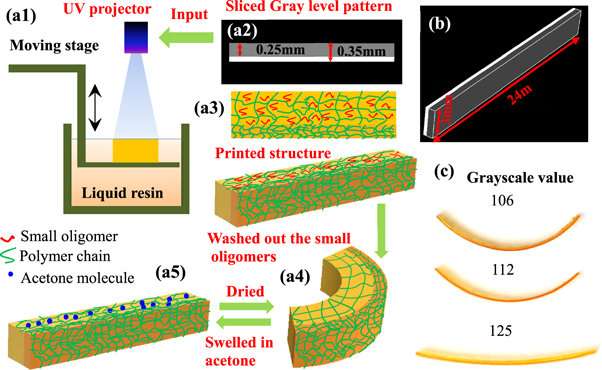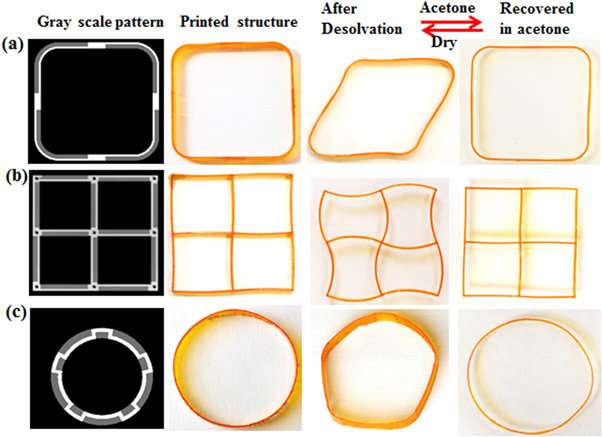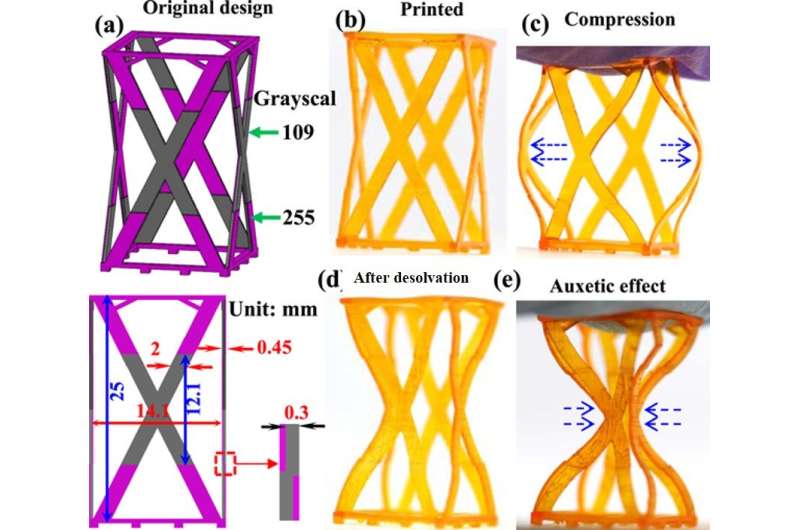The grayscale 4D printing method a1) schematics of the method with digital light processing (DLP), a2) representative grayscale pattern for printing, a3) schematics of a printed structure with different crosslinking density, a4) the structure bent after desolvation in water, a5) the structure can be recovered in acetone, b) an example design of a grayscale printing structure, c) variability of bending deformation with different grayscale values. Credit: Multifunctional Materials, doi: 10.1088/2399-7532/aac322
Reversible shape change is a highly desirable property for many biomedical applications, including mechanical actuators, soft robotics and artificial muscles. Some materials can change size or shape when irradiated with light, triggering mechanical deformation without direct contact offering prospects for remote control. To engineer reversible, shape changing (RSC) structures—active materials that respond to external stimuli such as light, heat or electric fields are used together with other nonactive materials. Although advanced multi-material 3-D printing has enabled the design and fabrication of RSC structures, only specific materials can be printed, restricting broad use.
As an alternative, a simpler method was recently presented using the 'grayscale pattern' to control light intensity distribution of a projected pattern on photopolymers or light-activated resins and induce crosslinking to create reversible, self-folding and unfolding 2-D origami structures. Different light intensities resulted in different crosslinking densities within the photocured polymer sheets. In a new study, Qi and co-workers transferred the grayscale pattern for controlled light intensity distribution from a 2-D surface to 3-D printing to engineer RSC structures layer-by-layer. If the grayscale patterns were designed well, a variety of 3-D structures with the capacity to shrink and swell reversibly in time (fourth dimension) for 4-D behavior were made possible. The results are now published in Multifunctional Materials, IOP Science.
As a proof of principle, the study used a digital light processing (DLP) printer for grayscale 4-D printing with a UV projector light source to print a photocurable liquid resin polymer composed of poly(ethylene glycol) diacrylate (PEGDA), butyl methacrylate (BMA), butyl acrylate (BA), photoinitiators and photoabsorbers. The structure of interest was first designed and sliced into pictures corresponding to each printing layer. The designed grayscale of each picture at different spatial positions was processed using Matlab and passed to the UV projector for printing. The principle of material fabrication was based on light irradiation for photoinduced hardening of the liquid resin solution. The engineered product was a structure with diverse crosslink densities at different spatial positions to enable reversible shape changes.
When the printed structure was immersed in a water bath, a process known as desolvation began, as small oligomers within the dissimilarly crosslinked material diffused out of the structure, allowing the printed structure to deform toward the less cured part. Based on the design of grayscale patterns, a variety of self-folding structures were formed via desolvation induced deformation.
The shape change was reversible and relatively fast in a solution of acetone; structures absorbed the solvent to swell and recover its original shape while still in solution. The recovered structure would bend again upon removal from acetone, reversing to its secondary structure in air.
Reversible shape changing materials: swell in acetone and bend in air. Credit: Multifunctional Materials, doi: 10.1088/2399-7532/aac322
In principle, the grayscale value of each pixel of the sliced image controlled the light intensity or light dose, which influenced the final conversion of the material during printing. The process was digitized for precisely controlling the grayscale pattern and the resulting construct. Newly developed materials were characterized using ATR-FTIR (attenuated total reflection-Fourier transform infra-red spectroscopy) to measure the degree of cure (DoC) of the photopolymerized sample, followed by quantifying the young's modulus to test material stiffness, photo-curation reaction kinetics and the quantification of desolvation vs. recovery.
Reversible pattern transformation of printed grayscale patterns: (a-c) using grayscale picture patterns, the authors constructed different shapes that could change shape reversibly in water and in acetone, returning to a bent shape in air. Credit: Multifunctional Materials, doi: 10.1088/2399-7532/aac322
Active structures that change shape or function reversibly in response to external stimuli have applications in aerospace engineering, medical devices and flexible electronics as shape memory polymers. Self-expanding/shrinking structures are useful as light actuators and for applications as endovascular stents. Such designs were also engineered in the study as self-expanding/shrinking materials using the grayscale 4-D printing method. The time for transformation varied between 6 minutes in acetone and 25 minutes in air. The concept was then extended from a flat surface to a cube shape using the same method, the recovery time in acetone was about 4 min and drying time in air was 8 min. Using the same concept Wu et al. also created a flower-like structure to shrink in solution and blossom in air.
Reversible shape changing materials: change of shape from acetone to air to create a blooming flower. Credit: Multifunctional Materials, doi: 10.1088/2399-7532/aac322
The researchers additionally developed advanced auxetic structures or metamaterials (that intrinsically have a negative Poisson's ratio) combined with normal materials (positive Poisson's ratio) employing the printing technique, to engineer transformation between the two.
Transformation between normal and auxetic structures: a) the original design of the auxetic structure (in grayscale the purple component is visible as white), b) the printed structure, c) normal material properties seen under compression, d) material after desolvation, e) the transformed properties seen under compression. Credit: Multifunctional Materials, doi: 10.1088/2399-7532/aac322
The grayscale 4-D printing method was developed as a proof-of-principle to provide a simple and economical technique to create active structures. The authors propose a range of potential biomedical applications for the engineered materials as composite materials in soft robotics and endovascular stents.
More information: Jiangtao Wu et al. Reversible shape change structures by grayscale pattern 4D printing, Multifunctional Materials (2018). DOI: 10.1088/2399-7532/aac322
A. Sydney Gladman et al. Biomimetic 4D printing, Nature Materials (2016). DOI: 10.1038/nmat4544
Journal information: Nature Materials
© 2018 Phys.org




























